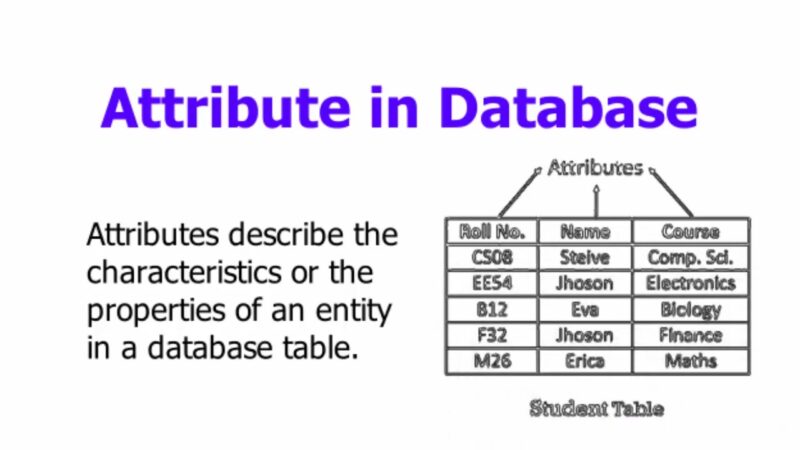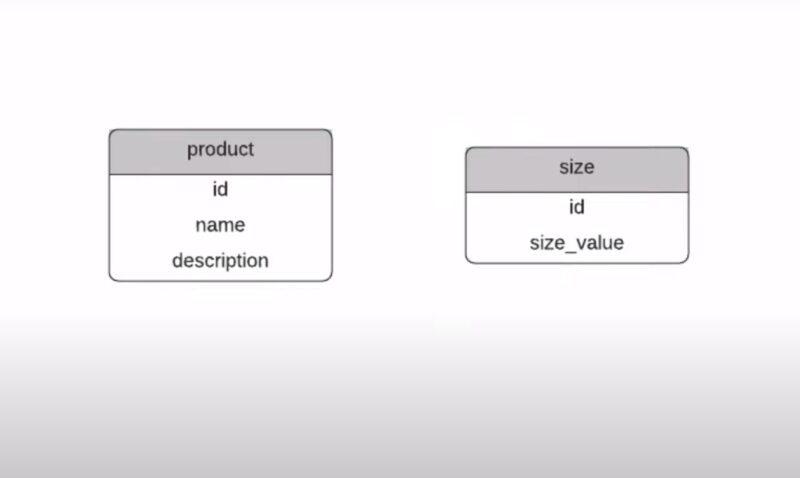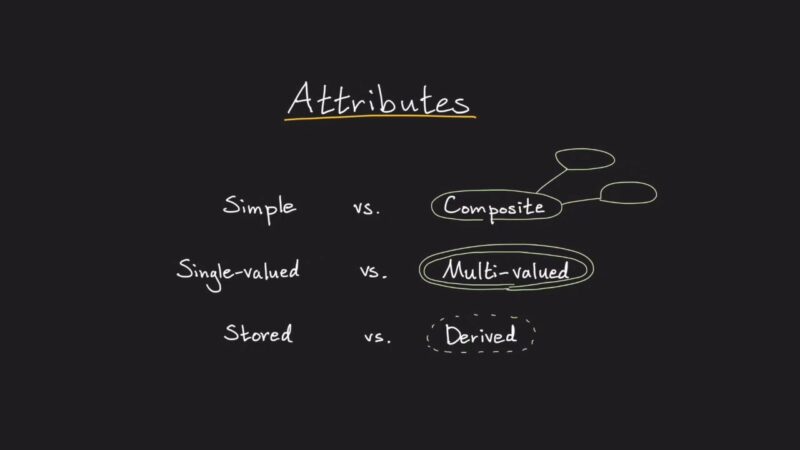Databases lie at the heart of modern software applications. Whether we’re accessing a social media site, booking a hotel room, or tracking our fitness activities, the underlying magic often happens in a database.
While terms like “SQL,” “tables,” and “records” have become somewhat familiar to many, the concept of an “attribute” remains slightly enigmatic to those not knee-deep in the tech world. So, what is this mysterious attribute? Today, we are going to talk about the world of database systems and unpack this essential component.
The Basics
In the vast realm of computer science, databases are akin to digital treasure chests. They store a plethora of information and make accessing this data quick and efficient.
But to understand the role attributes play in this system, we must first have a brief understanding of the databases themselves.
The Concept of Databases
Databases are structured collections of data. These structures enable efficient data retrieval and storage. In essence, a database serves as a digital filing system where:
- Data is stored in an organized manner.
- There’s a method to retrieve specific information.
- Mechanisms exist to safeguard this data.
Databases come in different types, from relational databases like MySQL and Oracle to non-relational ones such as MongoDB. But regardless of their type, a fundamental understanding of their components – tables, records, and attributes – is crucial.
Tables, Records, and Attributes
Within a database, the primary structure for organizing data is the table. A table comprises rows and columns reminiscent of a spreadsheet. Each row, often referred to as a record, represents a unique entry or item in the table. Columns, on the other hand, are where our enigmatic attributes come into play. To put it simply:
- Rows/Records: Unique entries in a table.
- Columns/Attributes: Specific pieces of information about those entries.
Imagine a table for books. Each record could represent a different book, while the attributes could include details like title, author, publication year, and genre.
The Pillars of Data

Now that we’ve set the stage with a basic understanding of databases let’s zoom in on attributes. These components are pivotal in providing the granularity and specificity databases need to be useful.
Defining the Attribute
In the realm of databases, an attribute is a property or characteristic of an entity or object. Think of it as a descriptor. Going back to our book example:
- Title: “To Kill a Mockingbird”
- Author: “Harper Lee”
- Publication Year: 1960
- Genre: “Fiction”
Each of these descriptors (title, author, etc.) is an attribute of the book. They define specific aspects of the entity in question. Importantly, attributes can have different data types – like text, numbers, dates, and more.
Attributes vs. Fields: Clearing the Confusion
It’s common to hear the terms “attribute” and “field” used interchangeably. While they are closely related, they aren’t identical:
- Attributes: These represent the type of data. In our book example, ‘Title’ and ‘Author’ are attributes.
- Fields: These are the actual data values for the attributes in a record. For “To Kill a Mockingbird”, the field for the ‘Title’ attribute would be “To Kill a Mockingbird,” and for the ‘Author’ attribute, it would be “Harper Lee.”
In essence, if attributes are the question, fields are the answer.
Why Attributes Matter

They aren’t just jargon in the world of databases. Their inclusion and design have profound implications for how systems store, retrieve, and manipulate data.
The Role in Data Retrieval
When you query a database, you’re often asking it to fetch records based on specific attributes. For example, you might want:
- All books by “Harper Lee”.
- Novels published after 2000.
- Fiction works under 300 pages.
Each of these queries leverages attributes to filter and retrieve the desired records. Without attributes:
- Data retrieval would be haphazard and inefficient.
- Users wouldn’t be able to access specific data points easily.
- Databases would lose much of their utility.
Designing with Attributes in Mind
The way attributes are defined and structured can have significant impacts:
- Data Integrity: By setting constraints on attributes (like ensuring an email follows a specific format), databases can maintain the quality and accuracy of data.
- Performance: Well-defined attributes can speed up queries, making data retrieval faster.
- Flexibility: With attributes like ‘tags’ or ‘categories,’ databases can be more adaptable to varied and evolving data.
To optimize a database, understanding and leveraging the power of attributes is paramount.
Real-World Applications

The conceptual understanding of attributes is pivotal, but it becomes truly enlightening when we see these concepts in motion. In real-world scenarios, attributes define the very essence of how databases respond to our digital demands.
E-Commerce and Product Attributes
Imagine browsing an e-commerce platform like Amazon or eBay. Each product displayed is laden with attributes.
- Product Name: “Wireless Ergonomic Keyboard”
- Brand: “TechMaster”
- Price: $49.99
- Ratings: 4.5 stars
These attributes aren’t just static text. They play a dynamic role in the user experience:
- Filtering products based on price ranges.
- Sorting items by rating.
- Searching for a specific brand or product name.
Without these attributes, the entire e-commerce model would collapse. They enable efficient browsing, comparison, and purchase decisions for millions of products.
Social Media Profiles and User Attributes
Consider your profile on a social media platform like Facebook or Twitter. Your profile is a collection of attributes:
- Name: “Jane Doe”
- Location: “New York, USA”
- Bio: “Travel enthusiast and bookworm.”
- Birthday: “July 15, 1995”
These attributes do more than just provide a static digital ID. They:
- Help in customizing user experiences.
- Determine which ads or content to display based on location or interests.
- Enable features like birthday reminders for your friends.
Attributes on social media, thus, personalize our digital interactions, making platforms feel more connected and tailored to individual users.
What Future Holds
As the digital world progresses, so too does the complexity and capability of databases. This evolution brings about shifts in how we perceive and utilize attributes.
From Static to Dynamic
Traditionally, attributes have been fairly static in nature. However, with the advent of more advanced database systems and machine learning, attributes can now be dynamic. For example:
- A music app might have an attribute called “user mood,” which changes based on the type of songs listened to recently.
- An online shopping platform could have dynamic pricing attributes, changing in real time based on demand and stock.
Such dynamic attributes allow for richer, more personalized user experiences.
Attributes and Big Data
In the age of Big Data, where massive amounts of information are processed every second, attributes play a vital role in data categorization and analysis.
- Segmenting data for targeted marketing.
- Analyzing trends based on specific attributes like age, location, or purchase history.
- Predicting future patterns or behaviors using attribute-based models.
In the vast sea of Big Data, attributes serve as critical buoys, helping navigate and make sense of the information deluge.
FAQs

How are attributes different from entities in a database?
While both attributes and entities are foundational elements in databases, they serve distinct roles. An entity is a distinct object or concept in the database, often represented as a table.
For example, “Book” or “Author” can be entities. Attributes, on the other hand, describe the properties or characteristics of these entities. For the “Book” entity, attributes might include “Title,” “Publication Date,” or “Genre.”
Can an attribute have multiple values for a single record?
Typically, in a well-structured relational database, an attribute will have a single value for a specific record. However, there are scenarios where an attribute might seem to have multiple values.
In such cases, databases often use related tables and foreign keys to maintain normalization. For example, instead of having an attribute “Authors” with multiple values, there might be a separate “Authors” table linked to the “Books” table to handle books with multiple authors.
How do attributes relate to primary and foreign keys in databases?
Primary keys and foreign keys are special types of attributes. A primary key attribute uniquely identifies each record within a table, ensuring that no two records have the same value for this attribute.
On the other hand, a foreign key is an attribute in one table that refers to the primary key attribute in another table. This linkage establishes a relationship between two entities and ensures referential integrity in the database.
What are composite attributes, and how are they different from simple ones?
Composite attributes are the ones that can be divided into smaller sub-parts, which represent more basic attributes with independent meanings.
For instance, a “Full Name” attribute can be divided into “First Name” and “Last Name”. Simple attributes, in contrast, are atomic and cannot be further subdivided. An example would be an “Email Address”.
How are derived attributes different from stored ones?
Derived attributes are the ones whose values can be derived from other attributes in the database. For example, an “Age” attribute might be derived from a “Date of Birth” attribute.
In contrast, stored attributes are those where the actual value is stored in the database. In our example, “Date of Birth” would be a stored attribute.
How can attributes help in ensuring data security and privacy in databases?
Attributes play a pivotal role in defining access controls and encryption strategies. For instance, specific ones, like “Password” or “Social Security Number,” can be encrypted for additional security.
Moreover, by setting specific user privileges at the attribute level, databases can ensure that only authorized personnel can access or modify sensitive attributes.
Final Words
Attributes, while perhaps overshadowed by the more commonly discussed elements of databases, play an indispensable role in the world of data. They give specificity, structure, and substance to the vast information reservoirs we rely on daily.
Whether you’re an aspiring tech enthusiast, a seasoned developer, or just someone curious about the digital world, grasping the concept of attributes is a step closer to understanding the intricate dance of data in our modern age. Our website covers a wide variety of technology topics, so make sure to revisit us and stay up-to-date with the latest trends.
